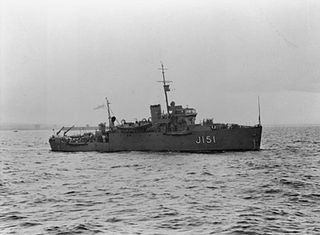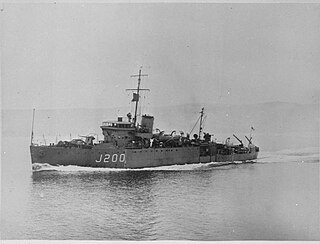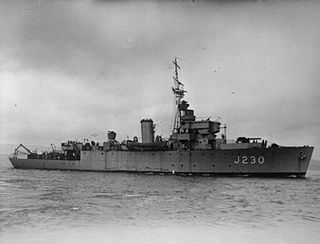
HMS Peterhead was a Bangor-class minesweepers built for the Royal Navy during the Second World War.

HMS Hebe was one of 21 Halcyon-class minesweepers built for the Royal Navy in the 1930s. Commissioned in 1936, Hebe served during World War II, notably taking part in the Dunkirk evacuation in 1940 and then serving in the Mediterranean, carrying out minesweeping operations from Malta. After taking part in several landing operations, including Operations Harpoon and Torch, and the invasion of Pantelleria, Hebe was sunk by a mine off Bari in November 1943, with the loss of 37 of the vessel's crew.

HMS Hythe was a Bangor-class minesweeper built for the Royal Navy during the Second World War.

HMS Clacton was a Bangor-class minesweepers built for the Royal Navy during the Second World War.

HMS Ardrossan was a Bangor-class minesweepers built for the Royal Navy during the Second World War.
HMS Felixstowe was a Bangor-class minesweepers built for the Royal Navy during the Second World War.

HMS Cromer was a Bangor-class minesweepers built for the Royal Navy during the Second World War.
HMIS Kathiawar (J155) was a Bangor-class minesweeper built for the Royal Navy, but transferred to the Royal Indian Navy (RIN) during the Second World War.
HMIS Baluchistan (J182) was a Bangor-class minesweeper built for the Royal Navy, but transferred to the Royal Indian Navy (RIN) during the Second World War.
HMIS Khyber (J190) was a Bangor-class minesweeper built for the Royal Navy, but transferred to the Royal Indian Navy (RIN) during the Second World War.
HMIS Rohilkhand (J180) was a Bangor-class minesweeper built for the Royal Navy, but transferred to the Royal Indian Navy (RIN) during the Second World War.
HMIS Kumaon (J182) was a Bangor-class minesweeper built for the Royal Navy, but transferred to the Royal Indian Navy (RIN) during the Second World War.
HMIS Carnatic (J182) was a Bangor-class minesweeper built for the Royal Navy, but transferred to the Royal Indian Navy (RIN) during the Second World War.
HMIS Rajputana (J197) was a Bangor-class minesweepers built for the Royal Navy, but transferred to the Royal Indian Navy (RIN) during the Second World War.

HMIS Orissa (J200) was a Bangor-class minesweepers built for the Royal Navy, but transferred to the Royal Indian Navy (RIN) during the Second World War.
HMIS Konkan (J228) was a Bangor-class minesweepers built for the Royal Navy, but transferred to the Royal Indian Navy (RIN) during the Second World War.
HMIS Deccan (J129) was a Bangor-class minesweepers built for the Royal Navy, but transferred to the Royal Indian Navy (RIN) during the Second World War.
HMS Lyme Regis was a Bangor-class minesweeper built for the Royal Navy during the Second World War.

HMS Spanker (J226) was a turbine engine-powered Algerine-class minesweeper during the Second World War. She survived the war and was sold to Belgium in 1953 as De Brouwer (M904).

HMS Cadmus (J230) was a turbine engine-powered Algerine-class minesweeper during the Second World War. She survived the war and was sold to Belgium in 1942 as Georges Lecointe (M901).








